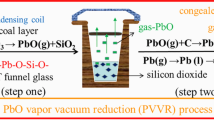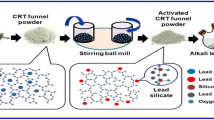Abstract
Cathode ray tube funnel glass is an environmentally problematic relict of old television sets. In particular, landfilling of this material is strongly discouraged because of its high lead content. However, recovery of this toxic lead could prevent its release into the environment and allow its reuse. In this research, lead was separated from the glass matrix by a chloride volatilization process. Melting of the funnel glass together with CaCl2 resulted in the volatilization of 80 % of lead at 1,000 °C. The use of NaCl as a chlorination agent yielded less volatile lead, while poly(vinyl chloride) and gaseous HCl proved to be ineffective chlorination agents. The differences in the chlorination agent efficiencies could be attributed to differences in the corresponding formation of silicates. Energy-dispersive X-ray spectroscopy showed that diffusion plays an important role in the volatilization of PbCl2.







Similar content being viewed by others
References
Beerkens RGC (2001) Modeling the kinetics of volatilization from glass melts. J Am Ceram Soc 84(9):1952–1960. doi:10.1111/j.1151-2916.2001.tb00942.x
Chan CCY, Kirk DW (1999) Behaviour of metals under the conditions of roasting MSW incinerator fly ash with chlorinating agents. J Hazard Mater 64(1):75–89. doi:10.1016/s0304-3894(98)00227-1
Chen M, Zhang F-S, Zhu J (2009) Lead recovery and the feasibility of foam glass production from funnel glass of dismantled cathode ray tube through pyrovacuum process. J Hazard Mater 161(2–3):1109–1113. doi:10.1016/j.jhazmat.2008.04.084
Forster M (2012) Investigations for the environmentally friendly production of Na2CO3 and HCl from exhaust CO2, NaCl and H2O. J Clean Prod 23(1):195–208. doi:10.1016/j.jclepro.2011.10.012
Giergiczny Z, Król A (2008) Immobilization of heavy metals (Pb, Cu, Cr, Zn, Cd, Mn) in the mineral additions containing concrete composites. J Hazard Mater 160(2–3):247–255. doi:10.1016/j.jhazmat.2008.03.007
Jakob A, Stucki S, Kuhn P (1995) Evaporation of heavy metals during the heat treatment of municipal solid waste incinerator fly ash. Environ Sci Technol 29(9):2429–2436. doi:10.1021/es00009a040
Jakob A, Stucki S, Struis RPWJ (1996) Complete heavy metal removal from fly ash by heat treatment: influence of chlorides on evaporation rates. Environ Sci Technol 30(11):3275–3283. doi:10.1021/es960059z
Kageyama H, Osada S, Nakata H, Kubota M, Matsuda H (2013) Effect of coexisting inorganic chlorides on lead volatilization from CaO–SiO2–Al2O3 molten slag under municipal solid waste gasification and melting conditions. Fuel 103:94–100. doi:10.1016/j.fuel.2011.09.058
Kanari N, Gaballah I, Allain E (2001) A low temperature chlorination–volatilization process for the treatment of chalcopyrite concentrates. Thermochim Acta 373(1):75–93. doi:10.1016/s0040-6031(01)00454-3
Kim D, Quinlan M, Yen TF (2009) Encapsulation of lead from hazardous CRT glass wastes using biopolymer cross-linked concrete systems. Waste Manage 29(1):321–328. doi:10.1016/j.wasman.2008.01.022
Lee G-S, Song YJ (2007) Recycling EAF dust by heat treatment with PVC. Miner Eng 20(8):739–746. doi:10.1016/j.mineng.2007.03.001
MacKenzie JM, Canil D (2008) Volatile heavy metal mobility in silicate liquids: implications for volcanic degassing and eruption prediction. Earth Planet Sci Lett 269(3–4):488–496. doi:10.1016/j.epsl.2008.03.005
Matsuno M, Tomoda K, Nakamura T (2003) Volatilization mechanism of Pb from fly ash in municipal waste incinerator. Mater Trans 44(12):2481–2488
Miyoshi H, Chen D, Akai T (2004) A novel process utilizing subcritical water to remove lead from wasted lead silicate glass. Chem Lett 33(8):956–957
Nakada H, Mihara N, Kawaguchi Y, Osada S, Kuchar D, Matsuda H (2008) Volatilization behavior of lead from molten slag under conditions simulating municipal solid waste melting. J Mater Cycles Waste Manage 10(1):19–23. doi:10.1007/s10163-007-0193-x
Park K-S, Sato W, Grause G, Kameda T, Yoshioka T (2009) Recovery of indium from In2O3 and liquid crystal display powder via a chloride volatilization process using polyvinyl chloride. Thermochim Acta 493(1–2):105–108. doi:10.1016/j.tca.2009.03.003
Saikia N, Kato S, Kojima T (2007) Production of cement clinkers from municipal solid waste incineration (MSWI) fly ash. Waste Manage 27(9):1178–1189. doi:10.1016/j.wasman.2006.06.004
Schabbach LM, Andreola F, Lancellotti I, Barbieri L (2011) Minimization of Pb content in a ceramic glaze by reformulation the composition with secondary raw materials. Ceram Int 37(4):1367–1375. doi:10.1016/j.ceramint.2010.12.009
Wang X-T, Xu B, Zhao D-N, Jin B-S (2010) Experimental analysis of heavy metals behavior during melting process of fly ashes from MSWI under different atmospheres. In: Bioinformatics and biomedical engineering (iCBBE), 2010 4th international conference on, 18–20. p 5516858. doi:10.1109/icbbe.2010.5516858
Yamashita M, Wannagon A, Matsumoto S, Akai T, Sugita H, Imoto Y, Komai T, Sakanakura H (2010) Leaching behavior of CRT funnel glass. J Hazard Mater 184(1–3):58–64. doi:10.1016/j.jhazmat.2010.08.002
Yoo J-M, Kim B-S, J-c Lee, Kim M-S, Nam C-W (2005) Kinetics of the volatilization removal of lead in electric arc furnace dust. Mater Trans 46(2):323–328
Yoshioka T, Saitoh N, Okuwaki A (2005) Temperature dependence on the activation energy of dechlorination in thermal degradation of polyvinylchloride. Chem Lett 34(1):70–71
Yot PG, Méar FO (2009) Lead extraction from waste funnel cathode-ray tubes glasses by reaction with silicon carbide and titanium nitride. J Hazard Mater 172(1):117–123. doi:10.1016/j.jhazmat.2009.06.137
Yuan W, Li J, Zhang Q, Saito F (2012) Innovated application of mechanical activation to separate lead from scrap cathode ray tube funnel glass. Environ Sci Technol 46(7):4109–4114. doi:10.1021/es204387a
Acknowledgments
This research was partially supported by the Ministry of the Environment through the Environmental Research and Technology Development Fund and Global Environment Research Fund, K113008.
Author information
Authors and Affiliations
Corresponding author
Rights and permissions
About this article
Cite this article
Grause, G., Yamamoto, N., Kameda, T. et al. Removal of lead from cathode ray tube funnel glass by chloride volatilization. Int. J. Environ. Sci. Technol. 11, 959–966 (2014). https://doi.org/10.1007/s13762-013-0286-0
Received:
Revised:
Accepted:
Published:
Issue Date:
DOI: https://doi.org/10.1007/s13762-013-0286-0




